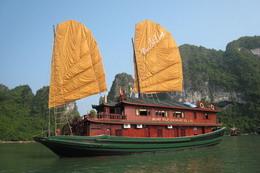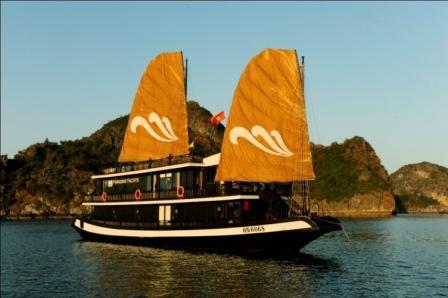Wind, solar power remain largely untapped resource
Published: 14/12/2008 05:00
| VietNamNet Bridge – The director of the Viet Nam Energy Consulttancy Centre, To Quoc Tru, spoke to Viet Nam News about the nation’s potential for alternative energy development.
At present, Viet Nam’s leading wind power station on Bach Long Vy Island in the northern port city of Hai Phong has a capacity of just 0.8MW, and the only wind and solar power stations that are connected to the national grid are the 150kW solar panels at the Ha Noi National Convention Centre. With national electrical capacity this year increasing to 15,000MW, the proportion of these renewable sources is actually becoming smaller, not larger, although solar panels have been becoming more popular in rural, mountainous and remote areas and have been installed in 38 cities and provinces as well as by some ministries. What is being done to promote renewable energy? There is a master plan to develop the country’s renewable energy resources through 2015, with a vision to 2025, that has been approved by the Ministry of Industry and Trade. But I also think there needs to be a longer-term strategy to 2050, approved by the Government, so all ministries and sectors will be able to join in the effort to develop green energy. The task at hand is to measure wind speed and solar radiation in various regions to map out specific plans. A law on renewable energy also should be drafted and submitted to the National Assembly for consideration and passage, while human resources for the sector continue to be a problem. What is the plan over the next 20 years? According to figures provided by more than 100 weather stations measuring sunshine throughout the country, Viet Nam is capable of developing solar energy in the central and southern regions where the sun shines year-round. Average solar radiation intensity has been recorded at 5kWh/m2 in these regions, compared to about 4kWh/m2 in the north due to heavy cloud cover in winter and spring. So, the theoretical capacity is estimated at 43.9 billion tonne-of-oil equivalents (TOE) per year. Stable solar sources can be used to partly meet energy demands for households in remote and mountainous regions and islands, as well as for production and connection with the national grid. Generating wind and solar power is difficult since the equipment and technology are expensive, but I believe that, in 10 or 20 years, solar energy will be one of our basic resources for ensuring national energy security. The Viet Nam power development strategy to 2020 with a vision to 2050 has set a target to increase the ratio of renewable energy to 5 per cent by 2020 and about 11 per cent by 2050. I hope that wind and solar energy can account for 50 per cent of total renewable energy – which also embraces waves, biomass and geothermal. The number is small but we have to try hard to reach this goal. Should Viet Nam focus just on these two alternative energy sources? There are two different ways of thinking. Some suggest building a high-capacity power plant in the central region, with the current connected to the national grid. Others support a smaller scale model focusing on households in outlying districts, in rural and remote areas. I support both approaches. There is no point in opposing high-capacity wind stations. Viet Nam had such good projects like the 50MW Phuong Mai project in Binh Dinh Province, the 30MW Tuy Phong project in Binh Thuan and the 40MW Tu Bong project in Khanh Hoa. PetroVietnam and Sai Gon Investment Corporation have also collaborated with foreign partners from Argentina and Japan respectively to build a wind-power station with a capacity of thousands of megawatts. Once in operation, these plants would help alleviate the nation’s power shortage. Meanwhile, small wind and solar stations on Phu Quy, Cu Lao Cham and Phu Quoc islands will also help improve the lives of local residents even though the energy does not join the national grid. But I think Viet Nam will still rely a lot on hydro, thermal and nuclear power because renewable energy will not be able to develop fast enough to replace these traditional sources. (Source: Viet Nam News) |
Provide by Vietnam Travel
Wind, solar power remain largely untapped resource - Sci-Tech - News | vietnam travel company
You can see more
- WIPO supports Vietnam to develop national strategy on intellectual property
- Viettel deploys 4G nationwide
- Wind power in Vietnam: three problems may shrink investors back
- Online sellers & buyers swindle each other
- Vietnam’s first remote sensing satellite launched after delay
- Vietnamese big guys vie with one another to distribute “eaten Apple”
- Broadcasters provide services below cost prices to attract more subscribers
- Vietnamese companies try to make money with garbage
enews & updates
Sign up to receive breaking news as well as receive other site updates!
- Banh Đa Cua - a traditional Hai Phong specialty
- Exploring Lai Chau cuisine
- Hanoi ranked top 3 cuisine in the world in 2023
- Beautiful resorts for a weekend escape close to Hanoi
- Travel trends in 2023
- In the spring, Moc Chau is covered in plum blossoms.
- The Most Wonderful Destinations In Sapa
- Top 3 Special festivals in Vietnam during Tet holiday - 2023
- 5 tourist hotspots expected to see a spike in visitors during Lunar New Year 2023
- How To Make Kitchen Cleaned
-
vietnam travel
http://www.vietnamtourism.org.vn " Vietnam Tourism: Vietnam Travel Guide, Culture, Travel, Entertainment, Guide, News, and...
-
Vietnam culture, culture travel
http://travel.org.vn " Vietnam culture
-
Vietnam travel, vietnam travel news, vietnam in photos
http://www.nccorp.vn " Vietnam travel, vietnam travel news, vietnam in photos
-
Vietnam tourism
http://www.vietnamtourism.org.vn " The official online information on culture, travel, entertainment, and including facts, maps,...
-
Vietnam Travel and Tourism
http://www.vietnamtourism.org.vn/ " Vietnam Travel, Entertainment, People, Agents, Company, Vietnam Tourism information.
-
Information travel online
http://www.travellive.org "Information travel online













